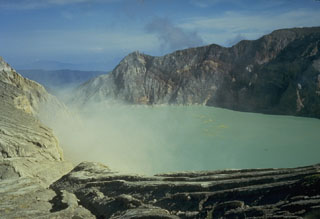Report on Ijen (Indonesia) — 7 August-13 August 2024
Smithsonian Institution / US Geological Survey
Weekly Volcanic Activity Report, 7 August-13 August 2024
Managing Editor: Sally Sennert.
Please cite this report as:
Global Volcanism Program, 2024. Report on Ijen (Indonesia) (Sennert, S, ed.). Weekly Volcanic Activity Report, 7 August-13 August 2024. Smithsonian Institution and US Geological Survey.
Ijen
Indonesia
8.058°S, 114.242°E; summit elev. 2769 m
All times are local (unless otherwise noted)
PVMBG reported that after a period of elevated seismicity at Ijen during 12-22 July, the number and magnitude of seismic events began to decrease. Realtime Seismic Amplitude Measurement (RSAM) data showed that the intensity of the seismicity began to decline on 13 July and, although there were fluctuations, seismicity had almost returned to normal levels. Visual observations during 1-12 August indicated that the color of the lake was the usual turquoise green, gas bubbles were not visible, there were fewer sulfur spherules, and white steam was not rising from the surface of the lake. The temperature of the crater lake water was 42.2-43.4 degrees Celsius. Dense white solfatara plumes rose from vents. A sulfur odor was present, but it was not strong. The lake water was 15.3 m below the dam. At 1300 on 13 August the Alert level was lowered to 1 (on a scale of 1-4) and residents, visitors, and miners were advised to not approach the crater rim, go down inside the crater, or stay overnight within 500 m of the crater rim.
Geological Summary. The Ijen volcano complex at the eastern end of Java consists of a group of small stratovolcanoes constructed within the 20-km-wide Ijen (Kendeng) caldera. The north caldera wall forms a prominent arcuate ridge, but elsewhere the rim was buried by post-caldera volcanoes, including Gunung Merapi, which forms the high point of the complex. Immediately west of the Gunung Merapi stratovolcano is the historically active Kawah Ijen crater, which contains a nearly 1-km-wide, turquoise-colored, acid lake. Kawah Ijen is the site of a labor-intensive mining operation in which baskets of sulfur are hand-carried from the crater floor. Many other post-caldera cones and craters are located within the caldera or along its rim. The largest concentration of cones forms an E-W zone across the southern side of the caldera. Coffee plantations cover much of the caldera floor; nearby waterfalls and hot springs are tourist destinations.
Source: Pusat Vulkanologi dan Mitigasi Bencana Geologi (PVMBG, also known as CVGHM)

